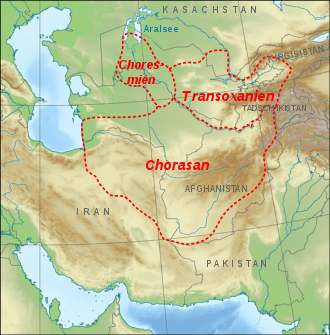Transoxiana


Transoxiana or Transoxania ("Land beyond the
Historically known in Persian as Farā-rūd (
The region of Transoxiana was one of the
History
Pre-Islamic period

The name Transoxiana stuck in Western consciousness because of the exploits of Alexander the Great, who extended Greek culture into the region with his invasion in the 4th century BCE. Alexander's successors would go on to found the Greco-Bactrian Kingdom, ushering in a distinct Greek cultural presence within Transoxiana that existed for over two hundred years. The city of Ai-Khanoum, situated on the Oxus in northern Afghanistan, remains the only Graeco Bactrian city to have been found and extensively excavated.[10]
During the Sasanian (Sassanid) Empire, it was often called Sogdia, a provincial name taken from the Achaemenid Empire, and used to distinguish it from nearby Bactria.
The Chinese explorer
before Sassanid rule.In Sasanian times, the region became a major cultural center due to the wealth derived from the
Islamic period
Many Persian nobles and landlords escaped to this region after the Muslim conquest of Persia. It was also ruled by Göktürks until the Arab conquest between 705 and 715, the area became known by the Arabic phrase Mā warāʼ al-Nahr "what is beyond the river", sometimes rendered as "Mavarannahr".
Transoxiana's major cities and cultural centers are
Part of this region was conquered by
In the early Islamic period, the people of Transoxania spoke Sogdian (an Iranian language) and were divided among several principalities.[12] The Arab conquest resulted in the spread of Arabic elite culture, and, more paradoxically, of Persian "as a spoken and eventually written language" in the region.[12] The Arab conquest also resulted in contacts with Tang China, where fragments of the Sasanian ruling elite, including Peroz III, had taken shelter after Iran's conquest by the Arabs.[12] However, it did not result in Transoxania having major interactions with Chinese culture.[12]
Religion
The historian Mark Dickens notes:[9]
Transoxiana's principal pre-Islamic religion was Zoroastrianism, albeit in local manifestations. However, Buddhism, [Nestorian] Christianity, Manichaeism, and Mazdakism also had many adherents, especially in urban areas. This initial religious diversity was gradually eroded after the Arab conquest.
Muslims had conquered Transoxiana by the 7-8th century. There were multiple figures in the Muslim world who had conquered these lands. Some include the Umayyad and Abbasid Arabs that took over lands that are now Uzbekistan, Tajikistan, Kazakhstan, and Kyrgyzstan.
Transoxania was a great center of Muslim civilization; it was the centre of the
An excerpt from a dynastic history commissioned by Eltüzer Khan of Khwarazm: "Oghuz Khan, who could speak at the age of one and whose first word was "Allah." He rebelled against his father, eventually slaying him, before embarking on a series of conquests that brought Islam to all of "Transoxiana and Turkestan."[14] [15]
See also
References
- ^ Connection of the Genetic, Cultural and Geographic Landscapes of Transoxiana Nature.com. By Maxat Zhabagin et. al. 08 June 2017. Accessed 23 January 2024.
- ^ "Transoxania (historical region, Asia)". Encyclopedia Britannica. Retrieved 2017-11-10.
- OCLC 794700604.
- ^ C. Edmund Bosworth, (2002), 'CENTRAL ASIA iv. In the Islamic Period up to the Mongols' Encyclopaedia Iranica (online)
- Cambridge University Press, 2000, p.4
- ^ "Khorāsān". britannica.com. Encyclopædia Britannica, Inc. Retrieved 14 November 2018.
- Fārs". (online)
- ^ C. Edmund Bosworth, (2011), 'MĀ WARĀʾ AL-NAHR' Encyclopaedia Iranica "It was defined by the early Arabic historians and geographers as the lands under Muslim control lying to the north of the middle and upper Oxus or Āmu Daryā, in contrast to Iran proper and its eastern province of Khorasan, sometimes called Mā dun al-nahr (lit. "what lies this side of the river"), although from the perspective of Arab historians writing in distant Iraq, the term "Khorasan" might extend to all lands beyond the Oxus, including Khwarazm and Transoxiana." (online)
- ^ a b Dickens 2018, pp. 1531–1532.
- ^ Rachel Mairs, The Hellenistic Far East
- ^ Silk Road, North China, C. Michael Hogan, The Megalithic Portal, ed. A. Burnham (2007)
- ^ ISBN 978-0-521-19074-9.
- ^ The Timurid Empire Archived 2009-08-16 at the Wayback Machine
- S2CID 240691206.
- ^ https://content.ucpress.edu/chapters/12768.ch01.pdf
Sources
- Dickens, Mark (2018). "Transoxiana". In Nicholson, Oliver (ed.). ISBN 978-0-19-866277-8.
